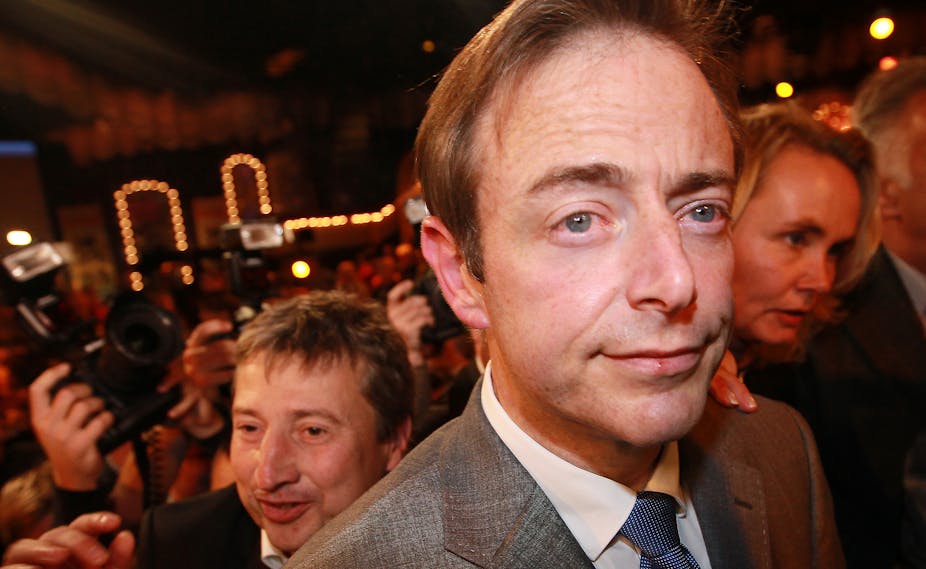On May 25 Belgium will hold its regional, federal and European elections. Like in 2010, the centre-right and Flemish nationalist New Flemish Alliance (Nieuw-Vlaamse Alliantie or N-VA) is expected to be the strongest party both in Flanders and in Belgium as a whole – even though it is not part of the country’s six-party ruling coalition, led by social-democrat Elio Di Rupo. From this position of strength, the N-VA’s proposals are dominating the election debate.
The N-VA, under the decade-long leadership of Bart de Wever, stands for confederalism in the short term and independence in the long term. The party proposes that Belgium would have two autonomous entities –- Flanders and Wallonia –- and a bilingual capital, Brussels.
The Belgian parliament and government would disappear and be replaced by a co-ordinating state authority that would not be directly elected. It would retain control over the army and diplomacy, but key issues such as social security, tax and labour policy would be transferred to Flanders and Wallonia.
Both regions currently have parliaments, which have relatively wide autonomy compared to some countries. They have responsibility for areas including education, environment, and culture; and are receiving extra powers and money as a result of the most recent state reform.
The N-VA sees confederalism as a tool to achieve socio-economic reforms. The party argues that there is a democratic deficit in Belgium because of the different political preferences in “liberal” Flanders and “socialist” Wallonia. Note that a similar argument has sometimes been used in Scotland to push for progressive policies, but in Flanders it is coming from the other side of the political spectrum. More autonomy would permit the N-VA to implement policies such as freezing public spending for two years and scrapping inflation-linked public sector pay rises.
The N-VA’s confederalism is part of a general trend among European sub-state nationalist parties to back away from classic notions of independence and to stress interdependencies. The Scottish National Party is a good example of this phenomenon too, since although it seeks Scottish independence, it wants to keep many British institutions such as the pound, the royal family and a common defence policy.
In Belgium, the N-VA’s emphasis on confederalism is also pragmatic: support for Flemish independence is only 15% at best. This is in clear contrast to support for independence in Scotland and Catalonia. Even the N-VA’s supporters prefer the continuation of the Belgian state with more autonomy for Flanders, so neither the N-VA nor the far-right Flemish Interest (Vlaams Belang) are calling for a referendum on independence.
The NVA’s coalition partners of choice in a Flemish government are the Christian democrats (CD&V) and the liberals (Open VLD), both of whom are in the Belgian ruling coalition. The three parties are in favour of a confederal model, but unlike the N-VA, the other two see it as a way to prevent the break-up of Belgium. The three parties also share a willingness to reach a balanced budget through austerity measures, although there are differences in the details.

At Belgian state level, things are more complicated. The N-VA is more prepared for compromises than in 2010, when its refusal to budge on the timetable for confederalism contributed to the near-two-year period when the country had no elected government. But the two biggest parties in Wallonia, the Francophone socialists (PS) and liberals (MR), are once again refusing to form a coalition federal government with them.
If the N-VA’s election result does not make it impossible to sideline them – “incontournable” as they like to say in Belgium – the traditional parties could repeat what they did in 2011 and join forces to form a federal government. That would once again raise problems of legitimacy and would again create a potentially unstable scenario for the country, where the N-VA would be in opposition at federal level but governing in Flanders.
For its part, the N-VA is only willing to join a centre-right federal coalition. This means that it needs the Francophone liberals to sign up. The two parties share a similar view on socio-economic matters, but the MR is against confederalism and is aware that agreeing with the N-VA would make them unpopular in Wallonia. This scenario would also leave the Francophone socialists, the strongest party in Wallonia, out of the federal government, which would also create a legitimacy problem for the new government.
In conclusion, the Belgian situation remains very complicated. The N-VA is certainly capitalising on the desire for change, but whether its confederalist dream will take place remains to be seen. The party could be left out of the cabinet in a new Di Rupo administration, or it could opt for forming a centre-right federal government and put territorial reforms on hold for now. Much will depend on the final distribution of votes and seats and on the parties’ capacity to reach compromises.
The rest of the Breaking Nations series on separatist regions around the world can be found here.

